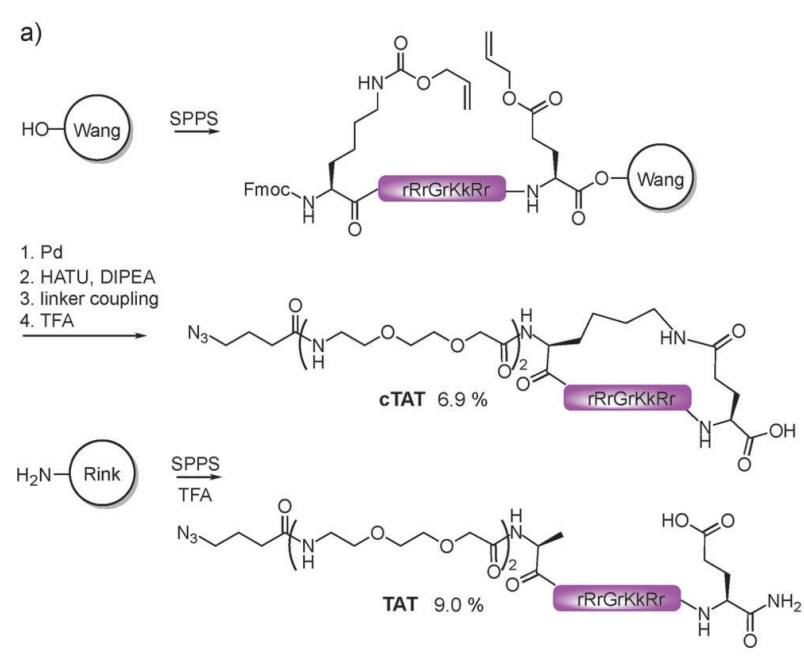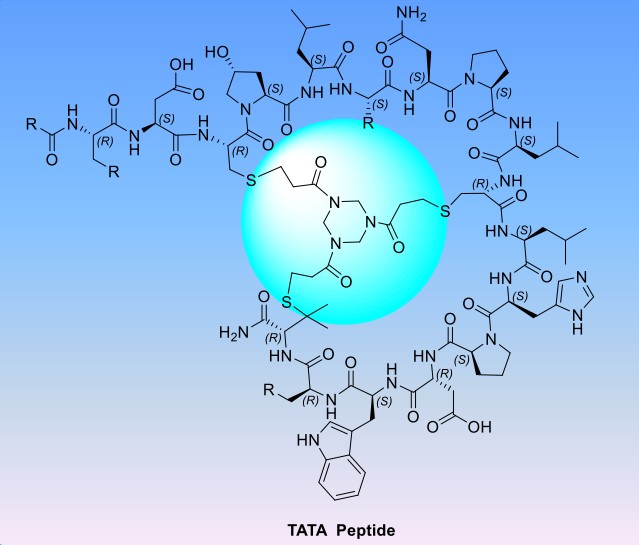As a leading biopharmaceutical company, Creative Peptides pays attention to the synthesis of TAT peptide, which is a subdivision of biopharmaceutical field and has great potential for breakthrough therapeutic application. We are proud to be at the forefront of this technology and provide services for the strategic creation and development of TAT peptides.
TAT peptides are a type of cell-penetrating peptide that are often used in biomedical research. They are derived from the HIV-1 virus and are used to deliver drugs or other molecules into cells. TAT peptides have potential application value because of their special cell permeability. They can transport protein, RNA, DNA and other biological macromolecules into cells through mechanisms such as endocytosis and direct penetration, and exert their effective functions. This makes them an important tool for the development of drug delivery or gene therapy technology, and has a good application prospect in the biomedical research field.
The delivery of free molecules into the cytoplasm and nucleus by using arginine-rich cell-penetrating peptides (CPPs) has been limited to small cargoes, while large cargoes such as proteins are taken up and trapped in endocytic vesicles. Nicole et al. discovered that the transduction efficiency of arginine-rich peptides, such as the TAT peptide, can be greatly enhanced by employing cyclic analogues. More specifically, they showed that the cyclization of arginine-rich peptides significantly increases the speed at which these peptides enter living cells.
The cyclic TAT peptide was synthesized on a standard Wang resin with orthogonal protecting groups at Lys and Glu for cyclization on the solid support. A cyclic TAT peptide with an N-terminal azide and an oligoethylene glycol spacer could be isolated in spite of its extreme hydrophilicity and in only one purification step through reversed phase HPLC at reduced flow rate in an overall yield of 6.9%.
 Fig.1 Synthesis of the peptides cTAT and TAT. (Nischan, N., 2015)
Fig.1 Synthesis of the peptides cTAT and TAT. (Nischan, N., 2015)
There are two types of linkage between TAT conjugates, one is covalent linkage, such as protein/peptide fusion molecule, and the other is non-covalent linkage, such as non-fusion.
Fusion expression has the advantage of high delivery efficiency, so it is widely used. Usually, covalent bonds are used to connect the membrane-penetrating peptide and the delivered molecule into a conjugate for delivery. The conjugate, TAT and botulinum toxin heavy chain fusion protein TAT-EGFPHCS, can be specifically delivered to the central nervous system through the blood-brain barrier. However, the biggest disadvantage of covalent bonding is that the connection process is complex, and there are different connection methods for different types of drugs, such as protein, nucleic acids and small molecular compounds. For protein, it is usually delivered in the form of fusion protein, for example, by constructing a fusion protein conjugate of TAT and RNA binding protein (HuR) to inhibit the expression of pro-inflammatory genes by competitively blocking the interaction between HuR and its partner. For nucleic acid molecules, they are usually connected by covalent coupling.
Although the delivery efficiency of non-fusion form is not as good as that of fusion form, the simplicity of non-fusion form is incomparable to that of fusion form. In the non-fusion form, molecules can be successfully delivered into cells without additional construction of expression plasmids or chemical conjugating.
The transmembrane mechanism of TAT has always been discussed. In 2004, Wadia et al. found that the transmembrane transduction of TAT may be endocytosis. In 2006, Tunnemann and others found that the form of TAT fusion protein entering cells was influenced by the size of the delivered molecule, and there were both endocytosis and direct internalization. Its endocytosis includes endocytosis and endocytosis. Yamano et al. found that the use of endocytosis inhibitors can significantly inhibit TAT from entering cells. In addition, the transmembrane mechanism of TAT may also be related to the charged nature of the delivered molecule, TAT concentration, temperature and cell type.
Cell permeability: The primary advantage of TAT peptides is their ability to translocate across the cell membrane. They provide a vehicle for delivering bioactive molecules, such as drugs, into cells. Through the use of TAT peptides, drug molecules can overcome cellular barriers that would normally prevent their entry into certain cells.
Wide range of applications: TAT peptides can be used in a variety of applications, including drug delivery, gene therapy, and basic research. The ability to deliver different types of molecules into cells expands the potential for therapeutic developments. They can be used in both in-vivo and in-vitro studies.
High efficiency: TAT peptides are known for their high efficiency in terms of delivering drugs into the cells. They can deliver larger and more complex cargos than other cell-penetrating peptides.
Stability: TAT peptides are relatively stable, allowing them to maintain their structure and function under a variety of conditions.
Dependability: TAT peptides have been used for several years with consistent and dependable results.
Versatility: They can be used to deliver a variety of different types of molecules into cells, including proteins, nucleic acids, and small molecules.
No activation needed: They do not require any activation steps, such as endocytosis, to penetrate the cell membrane.
TAT peptides are a type of cell-penetrating peptide (CPP) that can be used for a variety of purposes.
Drug delivery: TAT peptides can be used to deliver drugs into cells. They are often fused to the therapeutic molecules, allowing these molecules to penetrate the cell membrane and be delivered to the site of action within the cells.
Gene therapy: TAT peptides can also help to deliver DNA or RNA into cells as a part of gene therapy. The ability of TAT peptides to penetrate the cell membrane can facilitate the delivery of genes to cells, whether to replace a missing or defective gene or to provide a new function.
Imaging: Cell penetrating peptides can carry fluorescent or radioactive reagents for imaging.
Research tool: Researchers use TAT peptides as a tool to better understand how proteins function within cells by allowing them to deliver proteins and peptides into cells.
Vaccine development: TAT peptides can be used as adjuvants in vaccines to enhance immune responses.
Cancer treatment: TAT peptides can potentially be used to deliver cancer-killing agents directly to cancer cells, while sparing healthy cells.
Biomarker discovery: TAT peptides can be utilized in biomarker discovery for various diseases, given their ability to carry biomolecules into cells.
Neurological diseases: Research has shown that the TAT peptide can deliver neuroprotective agents across the blood-brain barrier, aiding in the treatment of neurodegenerative diseases.
Connection form of TAT and delivered molecule
Custom synthesis: We offer custom peptide synthesis, delivering TAT peptides tailored to your unique requirements. We have expertise in synthesizing TAT peptides with varying lengths and modifications, ensuring maximum efficiency and efficacy for your specific application.
 Fig. 2 Schematic diagram of TATA peptide.
Fig. 2 Schematic diagram of TATA peptide.
Comprehensive analytical services: With our in-depth analytical services, we provide insights into the structural characterization, purity assessment, and stability evaluation of TAT peptides. This knowledge is critical to optimizing peptide performance and ensuring regulatory compliance.
Peptide conjugation services: Through peptide conjugation, we can create TAT peptide conjugates capable of delivering a vast range of cargo molecules, from small molecule drugs to large proteins and nucleic acids.
Consultation services: Our team of experts are available to provide consultation on the design and application of TAT peptides, helping clients optimize their research and development processes.
Leading expertise: We have a highly skilled team of scientists with outmost expertise in the field of biomedical engineering and peptide synthesis.
State-of-the-art technology: Our company uses advanced technology and equipment to deliver high-quality TAT peptides.
Rich experience: We have successfully synthesized many TAT peptides.
Customized solutions: We offer fully customized peptide synthesis services to attain diverse research requirements of clients.
Exceptional purity: We guarantee peptides of excellent purity and accuracy, undergoing stringent quality control measures to ensure the highest standards.
Fast and dependable: We pride ourselves on delivering rapid and reliable services without compromising quality.
Confidentiality: We fully respect our client's confidentiality, all information related to the synthesis project will be strictly protected.
Competitive pricing: Despite our high-quality services, our prices are still competitive and affordable.
1. What is the use of TAT peptides?
TAT peptides are commonly used for intracellular delivery of bioactive molecules. They can carry and deliver proteins, nucleic acids, and nanoparticles into cells, both in vitro and in vivo, thereby making them useful in therapeutic and diagnostic applications.
2. What is the purity of the TAT peptides you synthesize?
We are capable of synthesizing TAT peptides with a purity of more than 95%. The exact purity will depend on the specific requirements of each customer's project.
3. Are there any potential risks or side effects with using TAT peptides?
While TAT peptides have been proven to be highly effective for research and drug delivery purposes, like any other medical treatment, there could be potential risks or side effects. However, potential risks largely depend on the type and quantity of cargo attached to the TAT peptide. As with any treatment, the benefits and risks should always be carefully evaluated.
4. How long does TAT peptide synthesis take?
The synthesis time can vary greatly depending on the complexity of the peptide sequence, the purity required, and the quantity needed. Typically, once the order is confirmed, it may take between 2-3 weeks for peptide synthesis. However, we always strive to deliver as early as possible without compromising quality.
References